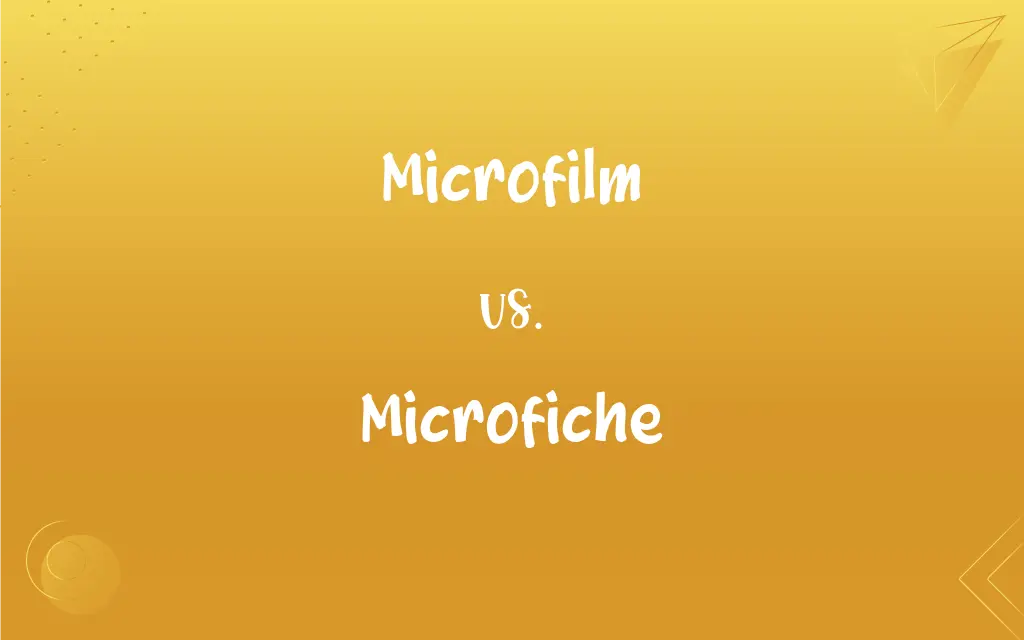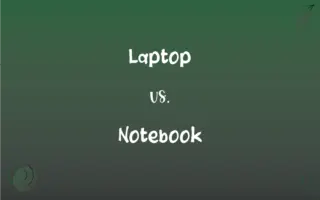Microfilm vs. Microfiche: What's the Difference?
Edited by Janet White || By Harlon Moss || Updated on July 10, 2024
Microfilm is a reel of film holding miniaturized photo images of documents, while microfiche is a sheet, holding images in a grid. Both are used for storing information in a reduced format.

Key Differences
Microfilm provides a unique approach to preserving and accessing documents in a compact manner. It consists of a long reel of film on which documents have been photographed and reduced in size to be stored efficiently. Microfilm utilizes sequential frames to store these images, typically in a linear format. Conversely, microfiche operates on a similar principle of storing miniaturized photographic copies of documents but implements a different physical format. Microfiche consists of a flat sheet of film, where images are organized in a grid. This grid format allows for relatively easy access to individual documents since users can navigate to a particular image without having to wind through a reel.
Another aspect to consider in microfilm is its typical use and storage requirements. Microfilm, being a reel, necessitates a specific type of reader, a microfilm reader, which allows for the scrolling through and magnifying of the miniaturized images. The process of scanning through microfilm can be linear and may require more time if the sought document is towards the end of the reel, which might impact user efficiency in accessing information.
In contrast, microfiche users typically employ a flatbed reader to examine the sheets, and because of its grid-like structure, it can be easier to locate specific documents quickly. Despite their differences, both microfilm and microfiche serve a crucial role in preserving documents, ensuring that valuable or historical information is not lost to time, degradation, or lack of physical storage space. Both have been pivotal, especially before the digital era, in maintaining records in libraries, archives, and information centers.
Comparison Chart
Format
Reel
Sheet
Access to Documents
Linear, scrolled access
Direct, grid-based access
ADVERTISEMENT
Storage Space
Can require more storage space
Compact, requires less space
Reader Type
Microfilm reader with reel ability
Flatbed reader
Typical Use Case
Extensive, continuous documents
Organized, specific documents
Microfilm and Microfiche Definitions
Microfilm
Microfilm is a storage medium that contains miniaturized photographic copies of documents on a reel of film.
The library maintains microfilm versions of old newspapers for archival purposes.
Microfiche
Microfiche is a flat piece of film containing microphotographs of the pages of a document.
Historical newspapers are often available on microfiche in public libraries.
ADVERTISEMENT
Microfilm
Microfilm allows for extensive documentation to be kept in a reduced, accessible format.
Years of town records are available on microfilm for public access.
Microfiche
Microfiche utilizes a grid layout, allowing users to rapidly locate specific information.
She quickly found the necessary document using the indexed grid on the microfiche.
Microfilm
Microfilm enables users to access older documents that may no longer be available in original formats.
Researchers use microfilm to access ancient manuscripts without handling the fragile originals.
Microfiche
Microfiche aids in preserving documents, especially when originals may be subjected to degradation over time.
Valuable manuscripts from the 18th century have been transferred to microfiche to prevent loss of information.
Microfilm
Microfilm is utilized to preserve historical documents, enabling compact storage and enhanced longevity.
To safeguard historical scripts, they were transferred to microfilm.
Microfiche
Microfiche can be easily viewed and explored using a special flatbed reader.
Scholars use a microfiche reader to explore ancient texts without damaging original manuscripts.
Microfilm
Microfilm is often used in libraries and archives to provide access to materials without exposing them to wear and tear.
Students explored archived microfilm to research the history of local journalism.
Microfiche
Microfiche serves as a tool to store numerous or bulky documents in a space-saving, archival format.
The archive stores old census data on microfiche to preserve it for future research.
Microfilm
A film on which printed materials are photographed at greatly reduced size for ease of storage.
Microfiche
(transitive) To convert (documents) to microfiche format.
Microfilm
A reproduction on this kind of film.
Microfiche
A card or sheet of microfilm capable of accommodating and preserving a considerable number of pages, as of printed text, in reduced form.
Microfilm
To reproduce (documents, for example) on microfilm.
Microfiche
A sheet of microfilm, six by four inches, holding several hundred reduced images of document pages, read using a microfiche reader or microfilm reader.
Microfilm
A continuous roll of film containing photographs of documents at a greatly reduced size
Microfiche
A device used to magnify and read these sheets.
Microfilm
To reproduce documents on such film
Microfiche
Small sheet of microfilm on which many pages of material have been photographed; a magnification system is used to read the material
Microfilm
A photographic film with one or more very small images of printed or other graphic matter. Numerous images, corresponding to the contents of a book, newspaper, or journal, are typically produced on one long roll of film, and may be viewed for reading in a special apparatus called a microfilm reader.
Microfilm
To photograph and produce images of on microfilm.
Microfilm
Film on which materials are photographed at greatly reduced size; useful for storage; a magnification system is used to read the material
Microfilm
Record on microfilm
FAQs
What is microfilm used for?
Microfilm is used for storing miniaturized photographic copies of documents to save physical space and preserve them.
How is microfilm created?
Microfilm is created by photographing documents and reducing the images to create a miniature, sequential film reel.
Are special skills required to create microfiche?
Creating microfiche does require knowledge of photographic processes and specific equipment to reduce and copy documents.
How does microfiche store information?
Microfiche stores information as small photographic images arranged in a grid on a flat sheet of film.
Can microfilm be converted to digital?
Yes, microfilm can be converted to digital formats using specialized scanning equipment.
What is the cost of converting microfilm to digital formats?
Costs can vary widely based on factors like image quality, quantity, and additional services like indexing.
What are the dimensions of a standard microfilm?
Standard microfilm generally comes in rolls that are 35mm or 16mm wide.
Is it easy to duplicate microfilm?
Yes, microfilm can be duplicated using specialized photographic processes to create additional copies.
Can color documents be stored on microfilm?
While possible, color microfilming is less common due to its complexity and cost compared to black and white.
Why use microfiche in libraries?
Libraries use microfiche to preserve and provide access to documents while protecting originals from wear and tear.
How long does microfilm last?
With proper storage, microfilm can last for centuries, preserving information for future generations.
Can microfiche be damaged easily?
Microfiche can be durable but can be damaged by improper handling, light exposure, and environmental factors.
How are documents arranged on microfiche?
Documents on microfiche are arranged in a grid, enabling users to quickly navigate to specific documents.
How many pages can be stored on a single microfiche?
A single microfiche can typically store around 60 - 98 pages, depending on the format and reduction ratio.
Why might institutions prefer microfiche over digital formats?
Some prefer microfiche due to its long-term stability, lack of technological obsolescence, and independent readability.
Can microfiche be used to preserve photographs?
Yes, microfiche can be used to preserve photographic images, though resolution and quality can be limited compared to originals.
Is microfilm still used today?
Yes, microfilm is still used, especially in archival contexts, although digital storage is becoming more prevalent.
How do I view a microfiche?
Microfiche can be viewed using a specific device called a microfiche reader, which magnifies the images.
Is microfiche a form of non-volatile storage?
Yes, microfiche provides a stable, non-volatile form of storage, preserving information without power.
How is information retrieved from microfilm?
Information on microfilm is retrieved by loading the film onto a reader, which allows scrolling and magnifying images.
About Author
Written by
Harlon MossHarlon is a seasoned quality moderator and accomplished content writer for Difference Wiki. An alumnus of the prestigious University of California, he earned his degree in Computer Science. Leveraging his academic background, Harlon brings a meticulous and informed perspective to his work, ensuring content accuracy and excellence.
Edited by
Janet WhiteJanet White has been an esteemed writer and blogger for Difference Wiki. Holding a Master's degree in Science and Medical Journalism from the prestigious Boston University, she has consistently demonstrated her expertise and passion for her field. When she's not immersed in her work, Janet relishes her time exercising, delving into a good book, and cherishing moments with friends and family.































































